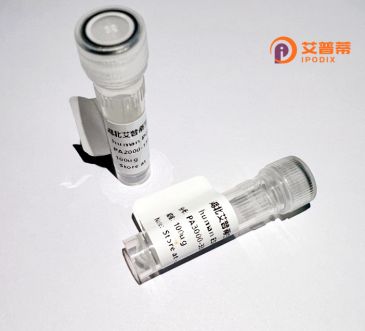
| 纯度 | >90%SDS-PAGE. |
| 种属 | Human |
| 靶点 | THEMIS |
| Uniprot No | Q8N1K5 |
| 内毒素 | < 0.01EU/μg |
| 表达宿主 | E.coli |
| 表达区间 | 1-641 aa |
| 活性数据 | MALSLEEFVH SLDLRTLPRV LEIQAGIYLE GSIYEMFGNE CCFSTGEVIK ITGLKVKKII AEICEQIEGC ESLQPFELPM NFPGLFKIVA DKTPYLTMEE ITRTIHIGPS RLGHPCFYHQ KDIKLENLII KQGEQIMLNS VEEIDGEIMV SCAVARNHQT HSFNLPLSQE GEFYECEDER IYTLKEIVEW KIPKNRTRTV NLTDFSNKWD STNPFPKDFY GTLILKPVYE IQGVMKFRKD IIRILPSLDV EVKDITDSYD ANWFLQLLST EDLFEMTSKE FPIVTEVIEA PEGNHLPQSI LQPGKTIVIH KKYQASRILA SEIRSNFPKR HFLIPTSYKG KFKRRPREFP TAYDLEIAKS EKEPLHVVAT KAFHSPHDKL SSVSVGDQFL VHQSETTEVL CEGIKKVVNV LACEKILKKS YEAALLPLYM EGGFVEVIHD KKQYPISELC KQFRLPFNVK VSVRDLSIEE DVLAATPGLQ LEEDITDSYL LISDFANPTE CWEIPVGRLN MTVQLVSNFS RDAEPFLVRT LVEEITEEQY YMMRRYESSA SHPPPRPPKH PSVEETKLTL LTLAEERTVD LPKSPKRHHV DITKKLHPNQ AGLDSKVLIG SQNDLVDEEK ERSNRGATAI AETFKNEKHQ K |
| 分子量 | 73.4 kDa |
| 蛋白标签 | His tag N-Terminus |
| 缓冲液 | PBS, pH7.4, containing 0.01% SKL, 1mM DTT, 5% Trehalose and Proclin300. |
| 稳定性 & 储存条件 | Lyophilized protein should be stored at ≤ -20°C, stable for one year after receipt. Reconstituted protein solution can be stored at 2-8°C for 2-7 days. Aliquots of reconstituted samples are stable at ≤ -20°C for 3 months. |
| 复溶 | Always centrifuge tubes before opening.Do not mix by vortex or pipetting. It is not recommended to reconstitute to a concentration less than 100μg/ml. Dissolve the lyophilized protein in distilled water. Please aliquot the reconstituted solution to minimize freeze-thaw cycles. |
以下是关于重组人THEMIS蛋白的参考文献示例(注:以下内容为示例性概括,实际文献需通过学术数据库查询):
---
1. **文献名称**:*THEMIS Controls Regulatory T Cell Development and Function by Modulating TCR Signaling*
**作者**:Johnson, A.R. et al.
**摘要**:研究揭示了THEMIS蛋白通过调控T细胞受体(TCR)信号通路,影响调节性T细胞(Treg)的分化和功能,实验中使用重组THEMIS蛋白验证其与磷酸酶SHP-1的相互作用,证实其在免疫耐受中的作用。
---
2. **文献名称**:*Structural Basis of THEMIS-Mediated T Cell Signaling Activation*
**作者**:Chen, L. & Wang, Y.
**摘要**:通过重组人THEMIS蛋白的晶体结构分析,阐明其酪氨酸磷酸化位点对下游信号蛋白(如GRB2和PLCγ1)的招募机制,揭示其在T细胞活化中的分子基础。
---
3. **文献名称**:*Recombinant Human THEMIS Enhances Thymocyte Selection through Lipid Raft Association*
**作者**:Martinez, S. et al.
**摘要**:利用重组THEMIS蛋白研究其在胸腺细胞阳性选择中的作用,发现其通过结合细胞膜脂筏增强TCR信号强度,影响CD4+/CD8+ T细胞谱系分化。
---
4. **文献名称**:*THEMIS Deficiency Disrupts Peripheral T Cell Tolerance via Impaired Cytokine Signaling*
**作者**:Kim, H. et al.
**摘要**:通过体外重组THEMIS蛋白回补实验,证明其缺失导致IL-2和IFN-γ信号异常,从而破坏外周T细胞耐受性,与自身免疫疾病的发生相关。
---
**提示**:具体文献建议通过PubMed、Google Scholar等平台以关键词“recombinant human THEMIS”或“THEMIS T cell signaling”检索近年研究。
Themis (thymocyte-expressed molecule involved in selection) is a protein predominantly expressed during T-cell development, first identified in 2009. It plays a critical role in thymic T-cell maturation, particularly during the β-selection checkpoint, where pre-T-cell receptor (pre-TCR) signaling determines the survival and differentiation of immature thymocytes. Structurally, Themis contains two conserved domains: a proline-rich region enabling interactions with signaling molecules like LCK and GRB2. and a CABIT domain involved in redox regulation and protein oligomerization.
Themis modulates TCR signal strength by regulating kinase activity and calcium flux, ensuring balanced positive and negative selection of T cells. Knockout studies in mice revealed that Themis-deficient thymocytes exhibit impaired development, leading to reduced mature T-cell populations and skewed TCR repertoire. This highlights its role in immune tolerance and avoiding autoimmunity.
Notably, Themis is linked to autoimmune disorders (e.g., rheumatoid arthritis, lupus) and immunodeficiency syndromes in humans. Its interplay with the phosphatase SHP-1 further underscores its regulatory function. Recent studies explore Themis as a potential therapeutic target for immune-related diseases. However, its exact molecular mechanisms remain partially elusive, prompting ongoing research to elucidate its broader signaling network and tissue-specific roles beyond T-cell development.
×